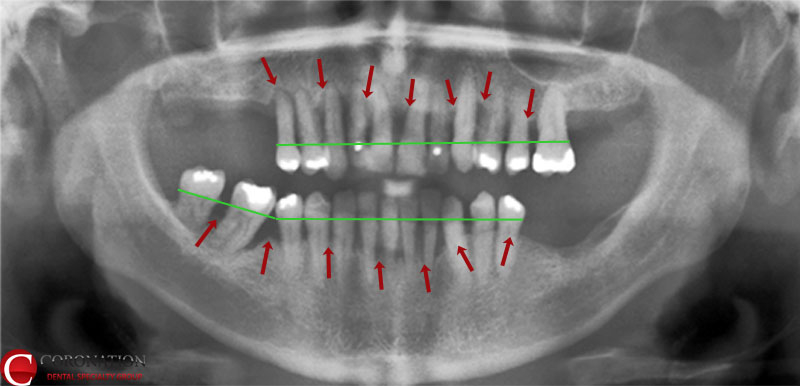Services > Periodontics > Gum Disease and Treatment
Dental health is not just teeth, but also includes the underlying support structures – the bone and gum tissue around your teeth. Gum (periodontal) disease can affect your oral health as much, or more, than cavities can affect your teeth. If you have significant gum disease, your dentist may refer you to a periodontist to evaluate the health of your gums, and to provide treatment to improve any gum disease.
Dr. Weitz is the periodontist with Coronation Dental Specialty Group. He will work closely with your dentist to provide you with excellent care.

An example of hopeless periodontal bone loss. There is significant loss of bone (red arrows), compared to where a healthy level of bone would be (green line). Due to the loss of bony support, most of these teeth cannot be saved.
At your first visit, your medical history will be reviewed, and there will be a gum examination and x-rays. The gum examination will usually involve identifying “pockets” around the teeth, and finding any pockets that are deeper than normal. Deep pockets are a concern because they can harbour plaque, tartar/calculus, and bacteria, which can result in a chronic inflammatory reaction, progressive loss of bone, and worsening gum health. X-rays are necessary to see the underlying bone and their shape and condition around the roots of the teeth.

Gum health worsens as more plaque and tartar builds around a tooth. Gum tissue becomes increasingly red and inflamed, and the pockets around a tooth deepen, making it more difficult to clean.
After gathering all the necessary information, your diagnosis and treatment plan will be discussed with you. Treatment may include a combination of sanitive or non-surgical therapy, re-evaluation, surgical therapy, and preventive/supportive maintenance.
Gum treatment starts with the least invasive, and most cost-effective method. Patients are given instruction in improving their oral hygiene, as this makes any future treatment more effective and predictable.
Scaling and root planing is completed next, and involves removal of hard and soft deposits of bacteria from the roots and teeth. This “deep cleaning” usually involves freezing, and allows gum inflammation to resolve. Other treatments may be provided, such as local placement of antibiotics, on a case-by-case basis.
After a healing period, you may notice contraction of the gums as the inflammation improves. This may sometimes result in tooth sensitivity or sometimes minor spaces showing between teeth.
It is important to evaluate the gum healing after treatment. If the gums have responded well to non-surgical treatment, then no further treatment is required and the patient can then simply undergo long-term preventive/supportive maintenance (see below).
However, in some cases there continues to be significant gum disease or pocketing, and further treatment is required.
If, after re-evalaution, there continues to be significant gum disease, minor localized surgery may be required to correct bone and gum defects, reduce and eliminate excess pocketing, or regenerate bone in the area. Dr. Weitz will carefully evaluate the your gum health, and make a recommendation about whether you would benefit from surgery, and what kind of surgery would be recommended. Different kind of surgical treatments may include Pocket Reduction Surgery, and Guided Tissue Regeneration.
After your gum health is stable, it should be constantly monitored to prevent any additional gum disease from occuring, and to quickly correct any disease that does recur before it becomes a significant problem.
Dr. Weitz will advise you on how frequently you should receive maintenance therapy. This involves reviewing oral hygiene, and scaling and root planing. The interval between appointments is usually between 3 and 6 months, depending on the health of your gums. Often, these appointments are alternated between your dentist’s office and our specialty office. This maintenance phase is the key to the long-term stability of your gum disease, and is important for long-lasting and predictable results.